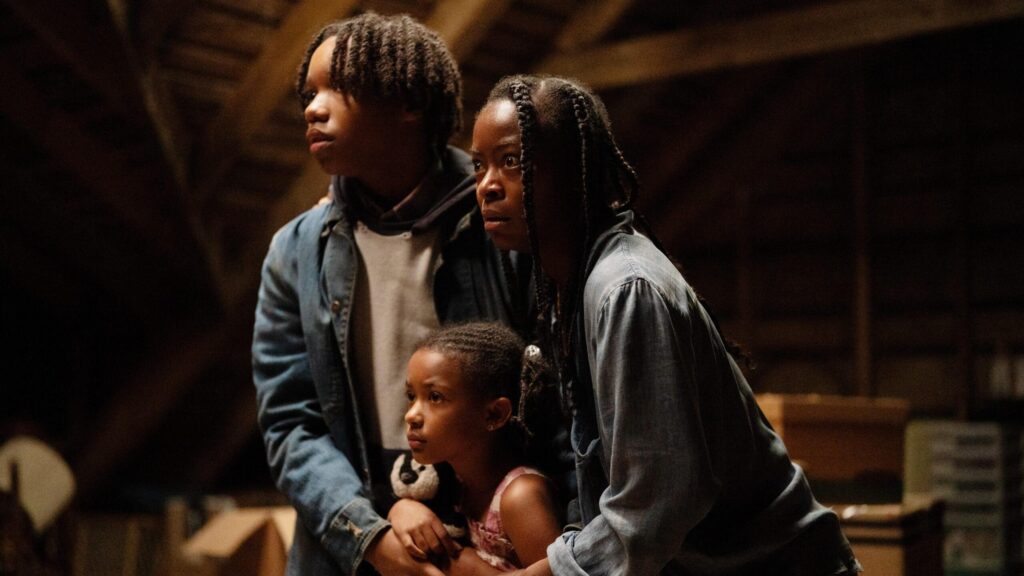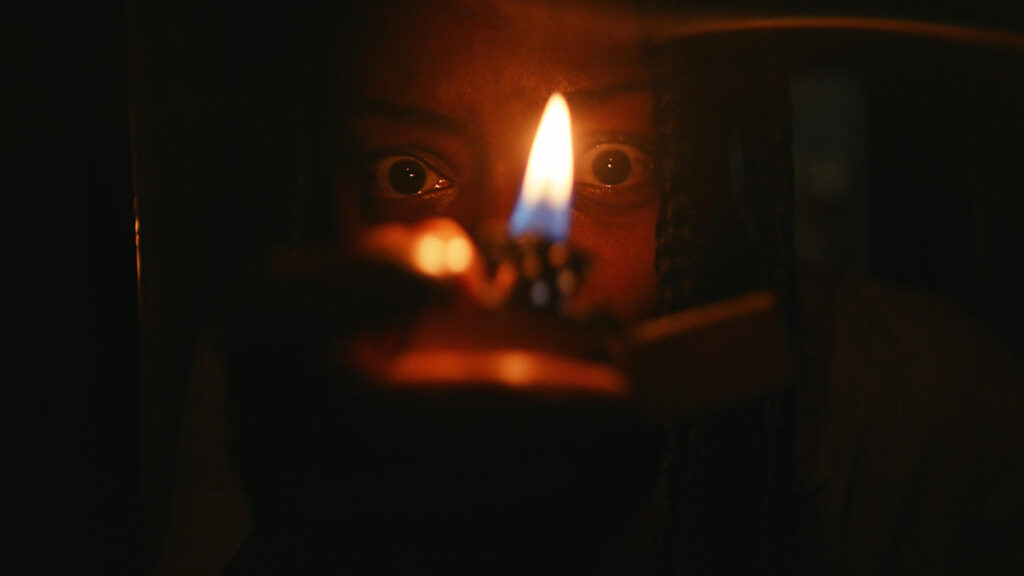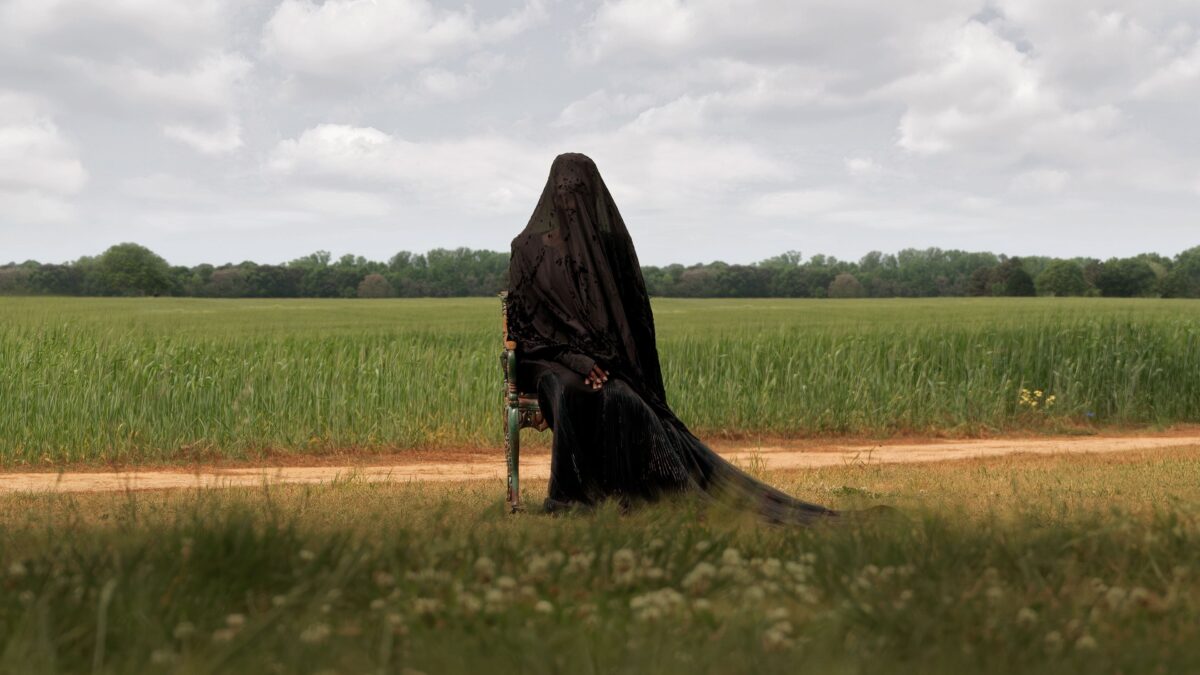My milkshake brings all the women to the yard
The woman is grief, but grief is complicated. Grief isn’t an isolated bruise that fades in a predictable pattern. It’s not something you can chart with a graph like you might a fever temperature. It coils around other feelings, picks up debris from every system a person lives inside. The woman is grief, but she is also Ramona’s (Danielle Deadwyler) guilt for the lies she told and the relationships she soured. She is systemic racism, debilitating poverty, and the weight of motherhood. The woman is subjugation, both physical and economic, unwillingly passed on to Ramona’s children. The woman is all of these at the same time she is grief, because these are the gears and levers of grief.
She is also in a yard! That is the stirring image at the heart of the film: A woman sitting quiet and unmoving just past Ramona’s front doorstep. The woman is, at first, a mere bother to Ramona’s family like a buzzing mosquito: always lingering, but not threatening enough to earn a full panic. And then, like any problem that you’re not equipped to solve, she builds and snaps with demonic force. She is a tumor diagnosed as benign until it’s suddenly Stage 4. Asking her politely just doesn’t work.

This is a horror movie with a premise so stripped-down that the title is essentially the synopsis. Ramona, a widowed mother disabled after a car accident that killed her husband, is now raising her kids Taylor (Peyton Jackson) and Annie (Estella Kahiha) in an isolated farmhouse. The money is running out. One day, the power shuts off thanks to an unpaid bill. That same day, a woman in black (Okwui Okpokwasili) appears on the edge of their property. She sits there doing nothing, but unease settles over the property; whether the malaise comes from anxiety or from spectral haunting is ambiguous. The pet dog vanishes. The family gradually loses their cool. It honestly reads like a creative exercise in limitation: how much can you wring out of a single setting, no incident, four characters, and an unsubtle metaphor?
Jaume Collet-Serra, the world-class B-movie stylist, takes this challenge like a dare. He does not upend the story, but he expands its reach. His direction is precise in transforming the lack of narrative event into an engine of tension. Each jingle of a wind chime and slanted ray of sun across unmowed grass becomes a portent of suffering. Each wide shot from the kitchen window toward the unmoving blot on the lawn offers nerve-wracking tension, like a stampede approaching. A walk to and from the garage becomes a set piece. That, I think, is why the movie works: Collet-Serra regards the story as a thriller and not a psychological drama.
Much of the film’s mood comes from cinematographer Pawel Pogorzelski, whose work here is simply masterful. He shoots the house and surrounding land like a toxic southern pastoral beginning to rot, Malick’s Days of Heaven stricken with disease. Interiors are gloomy but not gothic, conspicuously dusty and empty, with light that filters through curtains in crooked angles. Pogorzelski, who shot Hereditary and Midsommar, knows how to make mundane spaces feel charged with foreboding, but this is his best work I’ve yet seen. His camera with Collet-Serra’s clever direction is remarkable at capturing the geography of the scenario: we intuit the layout of the house, the position of the windows, the direction of the breeze. Shadow is crucially important, and it’s wonderfully shot at byzantine, disorienting angles.

The film is, essentially, a four-character piece: mother, son, daughter, ghost. All four performances are strong, but Deadwyler is a miracle. Her Ramona is breaking down in every possible sense — physically, emotionally, existentially. It’s a performance of staggering control: a woman who has been teetering on the brink so long that every minor problem threatens to push her over the edge. Her eyes and the way light reflects off of them tell a story on their own. My belief that she’s one of our great working actors increases with this film. Okpokwasili, who plays the titular woman, is memorable, too. She evokes Grace Jones — a sharp-angled, daunting beauty. Her voice modulates from angelic to guttural depending on the moment. She’s haunting even before the real haunting begins in the film’s second half.
The image of the woman herself is the film’s most powerful visual element. Draped in a sheer black veil, she’s both a corpse and a mourner. The sun shines through her gauze and she melts into the background. The design, reportedly based on artwork by Deadwyler herself, is an abstract painting come to life through cinematographic magic, clashing with the hyper-real southern landscape and skies. Even as we see her over and over, she is unsettling and unearthly.
The first half of The Woman in the Yard plays out almost entirely in daylight. It’s easier to keep your finger on the pulse of reality in the bright of day. Collet-Serra drips the tension into the film like we’re on an IV. When the woman finally triggers action, it’s rendered with both potential and kinetic energy: Ramona hobbles in and out of the house on her injured leg, scrambling for safety; Taylor holds a gun up to the woman, a future on the brink with a single trigger pull.

When night falls around the halfway point, the tone shifts from jittery suspense to phantasmagoric horror. As darkness in both lighting and mood descends, Collet-Serra and Pogorzelski shift their schema towards flashlight-lit terror. Shaky beams of light cut through a house that no longer feels like home. Collet-Serra plays with orientation: we lose our bearings on the space of the house, so cleanly rendered in the opening half, as do the characters. The climax spirals into a fugue of subjective imagery, with the line between hallucination and haunting blurry. Some of it conveys of narrative nonsense, pointing directly at themes, the camera’s grip on tactile reality lost, for better and worse: The stakes feel less real when we can’t trust our senses, but its such a bold contrast from the carefully honed opening, it retains a jarring punch until the closing minutes.
The ending is a thematic and narrative swing that will surely frustrate many viewers, in part because it’s ambiguous between opposite meanings. Did Ramona escape the spiral or fall into it? Could it somehow be both? There’s a reading of the ending where she slays her demons and awakes from a nightmare, grief subsided and family peace uneasily restored. There’s also a reading where Ramona submits to her suffering and embraces the shadow, the final images a state of purgatory. Given that this film is never about its story so much as scratching away at what “the woman” is and what Ramona can do about her unsolvable problems, I dug it.
What holds the movie back is part implicit, part contextual: It is more a one-sentence scenario than it is a story, and it is unabashedly “elevated horror” and “about trauma” in a time when those concepts are the opposite of fresh and incisive. To the extent that the movie works — and I know it’s not a surprise after all the nice things I’ve already said that I really think it does work — it is in spite of those limitations. And yet some of my hesitation will fade with time; powerful images tend to endure, tend to overcome structural directness, and this film has them.
I’m on the fence about whether The Woman in the Yard is one of the year’s crowning achievements or merely one of its sturdy delights. It does not surpass the ceiling of its pitch, though it hits that ceiling in a way too few movies do. Maybe I’ll revisit it down the line and wonder why it struck to me so hard this time through. There’s really not much to it. Or maybe the fact that it evokes so much with a such a simple setup is, indeed, its greatness. Something can be made from practically nothing. As Adam Nayman put it: “All it takes to make a movie is a woman and a yard.”
Is It Good?
Very Good (6/8)
Dan is the founder and head critic of The Goods. Follow Dan on Letterboxd. Join the Discord for updates and discussion.


6 replies on “The Woman in the Yard (2025)”
Made it to the margins of my attention, and it seemed like sort of a nullity (“hark! a Blumhouse!”), but maybe I’ll have to check it out. I have liked Collet-Serra, I mean The Shallows is *great.* I’ll have to force myself into catching up with Carry-On, thanks to it no longer being 2024 or relevant, though.
It’s not wrong to call it a “nullity” but it’s such a well-executed version of one I felt a lot of affection for it. I don’t know, maybe I’m on crazy pills.
Carry On is a lot of fun. I think you might like it. Probably more than this.
After going 2-for-2 on him in the past year, I definitely want to dig deeper into Collet-Serra’s films, and The Shallows is at the top of my list.
Well, there’s always Black Adam.
(Insert joke about “changing the hierarchy of power in the DC Universe”)
This is selling me on the movie more than any of the marketing did. (Did not realise it was the Hereditary/Midsommar DP!)
Yeah, it’s a really well shot film. Unabashedly elevated horror, but if you’re up for some, simple and strong example of the form